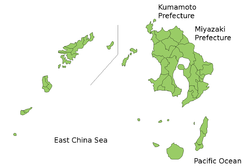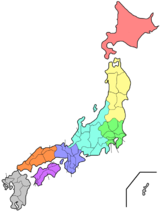Kagoshima Prefecture
| Kagoshima Prefecture | |||||||||
|
|||||||||
 |
|||||||||
| Capital | Kagoshima | ||||||||
| Region | Kyūshū | ||||||||
| Island | Kyūshū | ||||||||
| Governor | Yūichirō Itō | ||||||||
| Area (rank) | 9,132.42 km² (10th) | ||||||||
| - % water | 0.2% | ||||||||
| Population (2000) | |||||||||
| - Population | 1,786,214 (24th) | ||||||||
| - Density | 196 /km² | ||||||||
| Districts | 11 | ||||||||
| Municipalities | 49 | ||||||||
| ISO 3166-2 | JP-46 | ||||||||
| Website | www3.pref.kagoshima.jp/ foreign/english/ |
||||||||
| Prefectural symbols | |||||||||
| - Flower | Miyamakirishima (Rhododendron kiusianum) | ||||||||
| - Tree | Camphor laurel (Cinnamomum camphora) |
||||||||
| - Bird | Lidth's Jay (Garrulus lidthi) | ||||||||
| - Fish | {{{Fish}}} | ||||||||
Symbol of Kagoshima Prefecture |
|||||||||
| Template ■ Discussion ■ WikiProject Japan | |||||||||
Kagoshima Prefecture (鹿児島県 Kagoshima-ken) is a prefecture of Japan located on the island of Kyūshū. The capital is the city of Kagoshima.
Contents |
Geography
Kagoshima Prefecture is located at the southwest tip of Kyūshū and includes a chain of islands stretching further to the southwest for a few hundred kilometers. The most important group is the Amami Islands. Surrounded by the Yellow Sea to the west, at least since 1879 by Okinawa Prefecture in the south, Kumamoto Prefecture to the north, and Miyazaki Prefecture to the east, it has 2,632 km of coastline (including the 28 islands). It has a bay called Kagoshima Bay (Kinkowan), which is sandwiched by two peninsulas, Satsuma and Ōsumi. Its position made it a 'gateway' to Japan at various times in history. While Kyushu has about 13 million people there are less than 2 million in this prefecture.
The prefecture boasts a chain of active and dormant volcanoes, including the great Sakurajima, which towers out of the Kagoshima bay opposite Kagoshima city. A steady trickle of smoke and ash emerges from the caldera, punctuated by louder mini-eruptions on an almost daily basis. On active days in Kagoshima city an umbrella is advisable to ward off the ash. Sakurajima is one of Japan's most active volcanoes. Major eruptions occurred in 1914, when the island mountain spilled enough material to become permanently connected to the mainland, and a lesser eruption in 1960. Volcanic materials in the soil make Sakurajima a source for record daikon radishes, roughly the size of a basketball. Many beaches around the Kagoshima Bay are littered with well-worn pumice stones. A crater lake in the southwestern tip of the prefecture, near the spa town of Ibusuki, is home to a rare species of giant eel.

Some rural parts of the prefecture are experiencing population decline.[1]
History
Kagoshima Prefecture corresponds to the ancient Japanese provinces Ōsumi and Satsuma, including the northern part of the Ryukyu Islands. This region played a key role in the Meiji Restoration (Saigo Takamori), and the city of Kagoshima was an important naval base during Japan's 20th century wars and the home of admiral Tōgō Heihachirō. More recent incidents are the sinking of a North Korean spy ship (100 ton class) in 2001 by the coast guard, which was later salvaged and exhibited in Tokyo, and the abduction of an office clerk from a Kagoshima beach in 1978 by agents from the same country. This became known only recently under the Koizumi administration.
Economy
The prefecture has strong agricultural roots, which are reflected in its most well-known exports: green tea, sweet potato, radish, Pongee rice, Satsuma ware and Berkshire pork ("kurobuta"). Kagoshima prefecture's production of bonito flakes is second only to that of Shizuoka. In addition it produces Japan's largest volume of unagi eels.
The Japan Aerospace Exploration Agency (JAXA) has several facilities within the prefecture, including the country's main launch facility on Tanegashima and the Uchinoura Space Center.
The prefecture's gross domestic product is approximately 4.834 trillion yen.
Region
The following is a list of Kagoshima Prefecture's cities, and its administrative districts with their constituent towns and villages:
Cities
|
|
Districts
|
|
Mergers
In the 2000s, many administrative mergers of cities towns and districts have occurred in Kagoshima Prefecture.
Recreation
Although there are strong highschool teams, no major baseball or soccer club is based in the prefecture. A number of Kagoshima's ballparks play host to well-known teams:
- Kagoshima Prefectural Ballpark (鹿児島県立球場) Camp home of Chiba Lotte Marines
- Kagoshima Municipal Ballpark (鹿児島市営球場)
- Ibusuki Municipal Ballpark (指宿市営球場) Camp home of Kokutesu Swallows
- Yunomoto Ballpark (湯之元球場) Camp home of Yakult Atoms
- Kagoshima Prefectural Kamonoike Trackfield (鹿児島県立鴨池陸上競技場) Camp home of Júbilo Iwata
- Kagoshima Fureai Sportsland (鹿児島ふれあいスポーツランド) Camp home of Sagan Tosu
- Kagoshima Prefectural Kamonoike Trackfield (鹿児島県立鴨池陸上競技場) Camp home of Toshiba Fuchu Brave Rupas
The Kirishima-Yaku National Park is located in Kagoshima Prefecture.
No other prefecture has more pachinko parlors per capita than Kagoshima.
Colleges and Universities
- Kagoshima University (鹿児島大学)
- National Institute of Fitness and Sports in Kanoya (鹿屋体育大学)
- The International University of Kagoshima (鹿児島国際大学)
- Daiichi Institute of Technology (第一工業大学)
- Shigakukan University (志學館大学)
- Kagoshima Prefectural College (鹿児島県立短期大学)
- Kagoshima Immaculate Heart College (鹿児島純心女子短期大学)
- Kagoshima Woman's College(鹿児島女子短期大学)
- Daiichi Junior College of Infant Education (第一幼児教育短期大学)
- The International University of Kagoshima, Junior College (鹿児島国際大学短期大学部)
Notable people
- Hashiguchi Goyō (artist)
- Saigō Takamori (soldier)
- Iron Chef Hiroyuki Sakai (cook)
- Shimazu Nariakira (administrator)
- Kazuo Inamori (industrialist turned philanthropist)
- Mika Nakashima (modern day artist)
- Takehiko Inoue (modern comic artist)
- Kosuke Fukudome (MLB player)
Sister relations
- Miami, Florida
- Naples, Italy
- Jeollabuk-do, South Korea October 1989 duo-declaration
- Singapore
- Hong Kong
- Georgia, United States November 28, 1966 became a sister state
- Jiangsu, China
- Gifu Prefecture July 27, 1971 Became a sister prefecture
See also
- 2006 Kuril Islands earthquake
- Sakurajima daikon
External links
- (English) Official Kagoshima Prefecture homepage
- National Archives of Japan ... Kagoshima map (1891)
|
||||||||||||||
|
|||||||||||||||||||||||||||||||||
